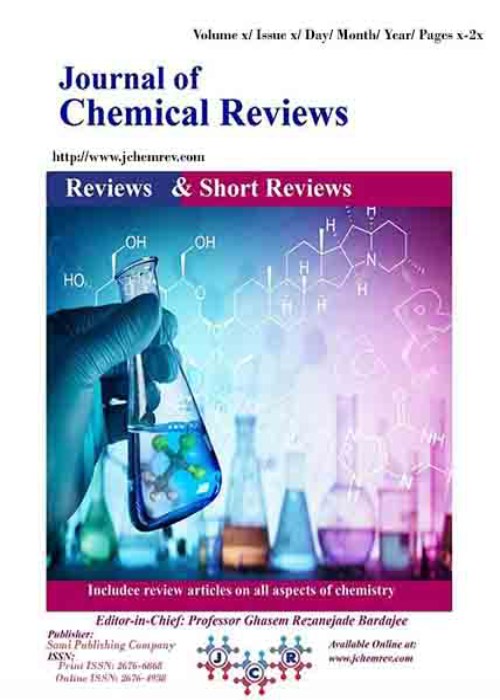فهرست مطالب

Journal of Chemical Reviews
Volume:5 Issue: 3, Summer 2023
- تاریخ انتشار: 1402/05/07
- تعداد عناوین: 6
-
-
Pages 221-240
One of the new global health risks is antimicrobial medication resistance. The creation of new and potent antimicrobial drugs is urgently needed due to the high mortality rate of this menace. One of the five-membered aromatic heterocycles subjected to the most inspection is the thiazole class. When it comes to therapeutic agents' antimicrobial action, the thiazole moiety is typically used as a fundamental framework. Many natural and synthetic thiazole derivatives have been found to exhibit significant biological activities. The current review gives a general overview of various thiazole synthesis techniques and describes various compounds with thiazole moiety with antimicrobial activity, which encourages further investigation into the development of thiazole-containing antimicrobial drugs.
Keywords: Thiazole, Synthesis, Antimicrobial, Resistance, antibacterial -
Pages 241-262
Imidazoles are key components of functional molecules with diverse applications. Due to its adaptive qualities in chemistry and pharmacology, its derivatives have attracted great study in recent years. The rapid growth of imidazole-based medicinal chemistry indicates the promising and potential therapeutic values of imidazole-derived compounds for treating irremediable diseases. This review is aimed on advances in the pharmacological activities of imidazole during past years such as anticancer, antioxidant, antibacterial, antifungal, antiviral, anti-tubercular, and anti-parasitic activity.
Keywords: Imidazole, Anticancer, antibacterial, Antifungal, Anti-tubercular -
Pages 263-280
Recently, synthetic scientists have become interested in potassium alum (KAl(SO4)2.12H2O), also referred to as "alum," as an effective, safe, and environmentally friendly acid catalyst for carrying out various organic transformations. The current mini-review piece provides an overview of the representative catalytic uses of this easily accessible and inexpensive inorganic sulphate salt in organic reactions that have been reported from mid-2017 to the present.
Keywords: Potassium alum (KAl(SO4)2.12H2O), Catalyst, Organic transformations, Heterocyclic ring formations -
Pages 281-310
Water adulteration is one of the serious concerns in Pakistan. Among 122 nations, Pakistan is positioned at rank 80 to provide water for drinking purposes. Water reservoirs including surface and groundwater are adulterated with toxic metals throughout the country. The acceptable limit set by the World Health Organization (WHO), Pakistan Environmental Protection Agency (Pak EPA), Health risk indicators are the Chronic Daily Intake (CDI), and the Health Risk Index (HRI) is consistently contravened. The main origin of heavy metals is industrial discharge, disposal of municipal waste, and use of agrochemicals are the main sources of water adulteration. This review discusses a brief layout of toxic heavy metals in water in Federally Administered Tribal Areas (FATA) Pakistan with a special insistence on heavy metal contamination. The data assembled in this review are obtained from different research articles published in national and international journals on toxic heavy metals in the particular region. Toxic heavy metals that as copper (Cu), cadmium (Cd), chromium (Cr), lead (Pb), nickel (Ni), (Fe) Iron, and manganese (Mn) are the most significant hazardous contaminants in different regions of FATA (Pakistan). The accumulation of heavy metals in the water reservoirs causes serious health risks to all living beings. This review is on the heavy metal in the water of different areas of FATA (Pakistan) in the last few years. The levels of heavy metal adulteration in different water sources were collected from various regions of FATA agencies. The research articles of respective authors helped to determine the heavy metal concentration mentioned in the standard literature. The determined concentration of some heavy metals was found safe mentioned by organizations that as the WHO, USEPA, EUC, and EPA. This review article aims to study the concentration of heavy metals in water sources of FATA (Pakistan).
Keywords: Toxic Heavy Metals, Water Quality, fata, Industrial Effluent, PTEs, Risk Assessment, Water adulteration -
Pages 311-340
The existence of the carcinogenic agent hydrazine poses a serious hazard to environmental wellbeing. Consequently, effective hydrazine detection in aqueous conditions becomes crucial. Novel sensing electrodes are being created through modifications using conducting polymers and nanomaterials, such as carbon-based nanomaterials, metallic nanoparticles, and metal oxide nanoparticles, in order to improve the selectivity and sensitivity of hydrazine detection. This review article offers a thorough assessment of the most recent developments in conducting polymer nanocomposites-based electrochemical sensing electrodes for hydrazine detection. These innovative electrodes are made to keep low detection limits while providing better sensitivity, selectivity, and durability. The review intends to provide information about the creation, evaluation, and performance of the sensing electrodes as well as their potential for practical use.
Keywords: Electrochemical sensors, Hydrazine, Conducting polymers, Nanocomposites, Nanotechnology, Voltammetric sensor -
Pages 341-352
Snake envenomation from different nations causes an emergency in public health, which result in high levels of mortality and morbidity. Snakebites are mostly treated with anti-venom administration to neutralize venom toxins. However, anti-venoms have some limitations due to their high cost, inadequate storage facilities, and hypersensitivity reactions in some people. This brings about the need to search for other alternatives in the snakebites treatment using medicinal plants. Plant extracts have been used over the years as an antidote in the treatment of envenomation by snakes worldwide. However, the efficacy of these plants has not been validated. This review aims at providing a mini review of some twenty-nine plant extracts used traditionally as antidotes to treat snakebites.
Keywords: Snakebites, Anti-venom, Plant extracts, treatment

